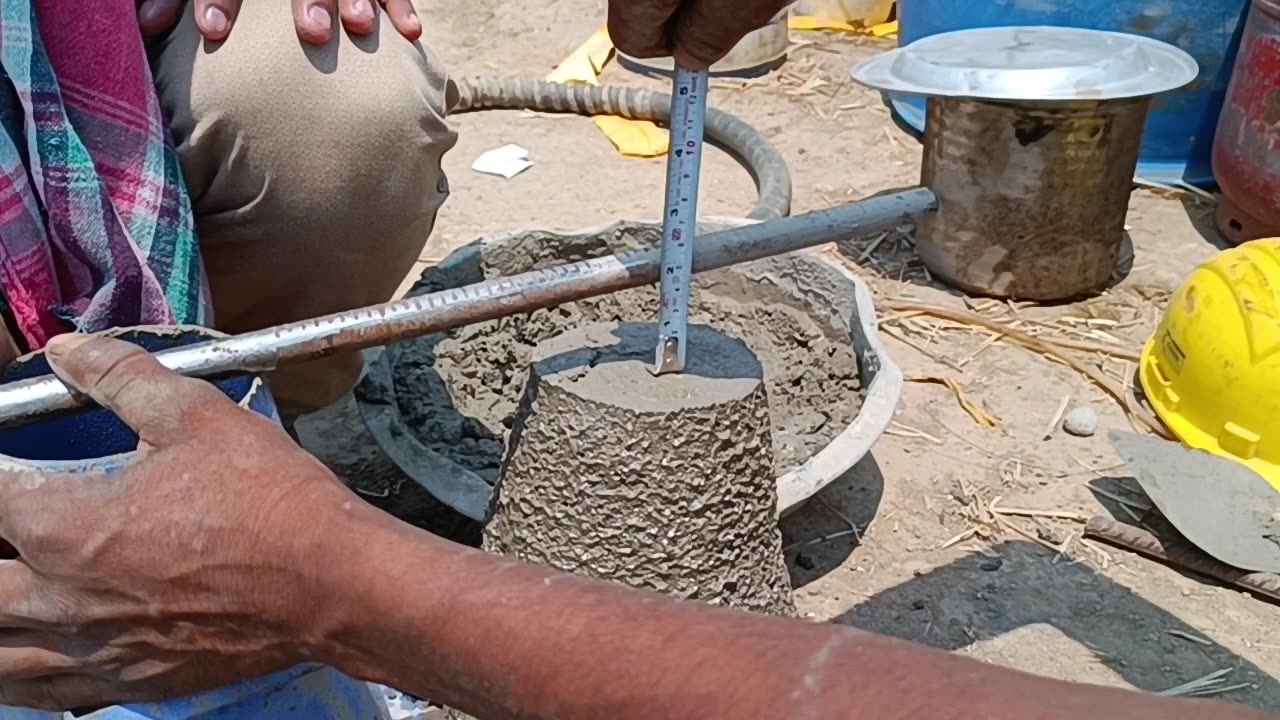Premium Only Content

Slump test in field
The slump test is a common procedure used to measure the consistency or workability of fresh concrete in the field. It provides an indication of the concrete's ability to flow and be easily placed. Here is a step-by-step guide on how to perform a slump test in the field:
1. Equipment Preparation:
- Slump cone: A frustum-shaped metal mold with a height of 12 inches (30 cm), an upper diameter of 4 inches (10 cm), and a lower diameter of 8 inches (20 cm).
- Tamping rod: A steel rod, 5/8 inch (16 mm) in diameter and 24 inches (60 cm) long.
- Measuring tape: To measure the slump.
- Stopwatches: To record the time.
- Clean water: To moisten the slump cone before testing.
2. Cone Preparation:
- Moisten the inner surface of the slump cone.
- Place the slump cone on a flat, non-absorbent surface (such as a metal plate) and secure it.
3. Filling the Cone:
- Fill the cone in three equal layers with freshly mixed concrete.
- Each layer should be compacted with 25 strokes of the tamping rod, uniformly distributed over the cross-section.
4. Striking off the Excess:
- After the final layer, strike off the excess concrete from the top of the cone using a trowel or a straightedge.
- Make sure the top surface of the concrete is level with the top edge of the slump cone.
5. Cone Removal:
- Hold the cone firmly and lift it vertically in a steady, upward motion.
- Avoid twisting or disturbing the concrete inside the cone.
6. Slump Measurement:
- Immediately after removing the cone, place the measuring tape next to the slumped concrete.
- Measure the vertical distance between the top of the cone and the highest point of the slumped concrete. This is the slump value.
7. Recording the Results:
- Record the slump value in millimeters or inches.
- Repeat the test at least two more times with fresh samples and record the results.
8. Cleaning and Reusing the Equipment:
- Clean the slump cone and tamping rod thoroughly after each use.
- Ensure that the equipment is dry and free from any concrete residue before the next test.
Remember, the slump test provides a measure of the consistency of concrete, and different construction projects may require specific slump ranges. Always consult the relevant specifications or project requirements to determine the acceptable slump value for your particular application.
-
 6:46:07
6:46:07
Rance's Gaming Corner
7 hours agoTime for some RUMBLE FPS!! Get in here.. w/Fragniac
107K1 -
 1:30:48
1:30:48
Josh Pate's College Football Show
7 hours ago $2.83 earnedCFP Reaction Special | Early Quarterfinal Thoughts | Transfer Portal Intel | Fixing The Playoff
16.1K -
 23:55
23:55
CartierFamily
3 days agoElon & Vivek TRIGGER Congress as DOGE SHUTS DOWN Government
61.3K82 -
 5:43:44
5:43:44
Scammer Payback
2 days agoCalling Scammers Live
146K21 -
 18:38
18:38
VSiNLive
2 days agoProfessional Gambler Steve Fezzik LOVES this UNDERVALUED Point Spread!
109K17 -
 LIVE
LIVE
Right Side Broadcasting Network
10 days agoLIVE REPLAY: President Donald J. Trump Keynotes TPUSA’s AmFest 2024 Conference - 12/22/24
4,501 watching -
 4:31
4:31
CoachTY
1 day ago $26.84 earnedCOINBASE AND DESCI !!!!
158K11 -
 10:02
10:02
MichaelBisping
1 day agoBISPING: "Was FURY ROBBED?!" | Oleksandr Usyk vs Tyson Fury 2 INSTANT REACTION
84.1K13 -
 8:08
8:08
Guns & Gadgets 2nd Amendment News
2 days ago16 States Join Forces To Sue Firearm Manufacturers Out of Business - 1st Target = GLOCK
110K88 -
 10:17
10:17
Dermatologist Dr. Dustin Portela
2 days ago $18.26 earnedOlay Cleansing Melts: Dermatologist's Honest Review
148K14